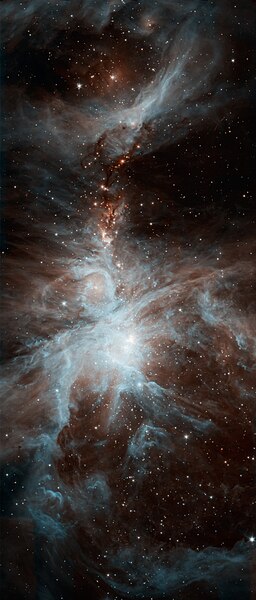File:Spitzer's Orion.jpg
外观

本预览的尺寸:256 × 600像素。 其他分辨率:102 × 240像素 | 205 × 480像素 | 328 × 768像素 | 437 × 1,024像素 | 2,171 × 5,085像素。
原始文件 (2,171 × 5,085像素,文件大小:1.44 MB,MIME类型:image/jpeg)
文件历史
点击某个日期/时间查看对应时刻的文件。
| 日期/时间 | 缩略图 | 大小 | 用户 | 备注 | |
|---|---|---|---|---|---|
| 当前 | 2010年4月10日 (六) 10:31 |  | 2,171 × 5,085(1.44 MB) | Originalwana | {{Information |Description={{en|1=A colony of hot, young stars is stirring up the cosmic scene in this new picture from NASA's Spitzer Space Telescope. The image shows the Orion nebula, a happening place where stars are born. The young s |
文件用途
以下2个页面使用本文件:
全域文件用途
以下其他wiki使用此文件:
- ba.wikipedia.org上的用途
- bn.wikipedia.org上的用途
- crh.wikipedia.org上的用途
- cv.wikipedia.org上的用途
- el.wikipedia.org上的用途
- en.wikipedia.org上的用途
- fa.wikipedia.org上的用途
- سحابی شکارچی
- ویکیپدیا:نگارههای پیشنهادی/ستارهشناسی
- ویکیپدیا:نگاره روز/اکتبر ۲۰۱۳
- کاربر:MMjex/نگارههای برگزیده
- ویکیپدیا:گزیدن نگاره برگزیده/مه-۲۰۱۳
- ویکیپدیا:گزیدن نگاره برگزیده/Spitzer's Orion.jpg
- الگو:نر/2013-10-30
- الگو:نر محافظت شده/2013-10-30
- بحث کاربر:MMjex/بایگانی ۱
- ویکیپدیا:نگارههای برگزیده/نگاه به فضا
- fr.wikipedia.org上的用途
- hu.wikipedia.org上的用途
- it.wikipedia.org上的用途
- ko.wikipedia.org上的用途
- krc.wikipedia.org上的用途
- lbe.wikipedia.org上的用途
- mk.wikipedia.org上的用途
- my.wikipedia.org上的用途
- no.wikibooks.org上的用途
- os.wikipedia.org上的用途
- pl.wikipedia.org上的用途
- ro.wikipedia.org上的用途
- ru.wikipedia.org上的用途
- ru.wikinews.org上的用途
- sah.wikipedia.org上的用途
- sr.wikipedia.org上的用途
- uk.wikipedia.org上的用途
- vi.wikipedia.org上的用途
- xal.wikipedia.org上的用途





